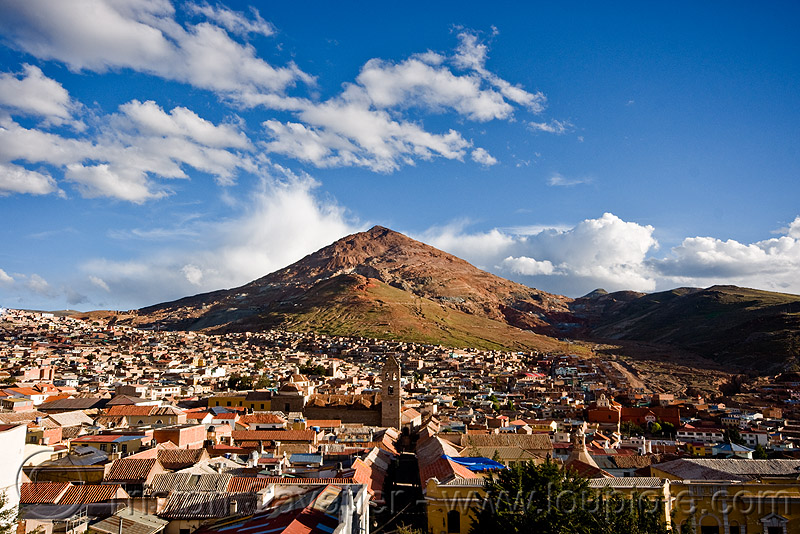In the year 1545, a man by the name Diego Huallpa accidentally discovered Potosi in Boliva, also known as Cerro Rico.1 Cerro Rico means rich mountains, which, in this case, it definitely was. When traveling between cities, Diego Huallpa was asked to climb a mountain; after getting to the top he slipped and fell and found on the side of the mountain some silver. Diego Huallpa immediately took his findings to his boss, which was a Spanish overseer at a nearby mine. Shortly after, that mountain was quickly inhabited by thousands of Spaniards and Indians. The silver of this mountain quickly drew the attention of the Spanish conquistadors. When these conquistadors arrived, they began to colonize the area surrounding the mountain.2 By 1672, the surrounding area reached its highest population of 200,000 people, and was one of the richest cities of its era.3 It became a very strong anchor for the Spanish Empire. This city sent Spain’s economy to new heights, making the Spanish more powerful than before.4
Silver during the sixteenth century was one of the most sought-after metals in all of Spain.5 The area itself surrounding the mountain was not a healthy environment, and the air was constantly filled with dust and debris. Miners were only expected to live to be around forty years old.6 To make matters worse, Potosi is the highest city in the world, making the air thin and hard to breathe. The city resides 4000 meters above sea level.7 All in all, the surrounding area was a cruel place to live, but the Spaniards stayed due to the wealth they achieved. This wealth was achieved easily for the Spanish, but came at a great price to the indigenous Indians and to the African slaves.8

Potosi was a cruel, horrible place for anyone who worked there. The process of mining in the sixteenth century was not an easy one. It was extremely laborious and hard for all miners. The Spanish conquered the Andeans and put them through rough, intensive work.9 Though the Indians were not slaves they were sometime treated as such. Some Spanish conquistadors would lend Indians under their care to other miners. At Potosi, as elsewhere in Spanish South America, the Spanish implemented the mita system of labor. In this system, miners would be given a certain number of days to work per week, and then they would relax on the other days. Though it was more intense, all ages would be put to work, ranging from eighteen to fifty years old.10 Before the Spanish empire found an easier way to mine, they used the classic way of mining, which was extremely laborious.11 The Indians were to use iron bars to chip out iron ores, which was then carried down the mountain, where it would be heated in order to extract the silver.12 The mountain was a very dangerous place, due to its close spaces with very little air.
The silver industry in the sixteenth century really flourished. It was in great demand and needed for the Spanish and Europeans.13 Even though mining slowed down after Bolivia received independence, Potosi, still to this day is a high producer of silver.14 The Potosi mountains have had several years where they have really good production, but that has also come with several bad years.15 Still to this day Potosi is a high producer of silver and tin, causing Potosi to be one of the oldest mining cities in the New World.16
- Oxford Research Encyclopedia, May 2015, s.v. “Potosí Mines,” by Kris Lane. ↵
- Oxford Research Encyclopedia, May 2015, s.v. “Potosí Mines,” by Kris Lane. ↵
- New World Encyclopedia, February 2017, s.v. “Potosí.” ↵
- Oxford Research Encyclopedia, May 2015, s.v. “Potosí Mines,” by Kris Lane. ↵
- History of World Trade Since 1450, 2006, s.v. “Potosí,” by Peter Bakewell. ↵
- New World Encyclopedia, February 2017, s.v. “Potosí.” ↵
- Oxford Research Encyclopedia, May 2015, s.v. “Potosí Mines,” by Kris Lane. ↵
- Tom Zoellner, “The Mountain That Eats Men,” World Literature Today (serial online) 88(3/4) (May 2014): 83-87. ↵
- Oxford Research Encyclopedia, May 2015, s.v. “Potosí Mines,” by Kris Lane. ↵
- Oxford Research Encyclopedia, May 2015, s.v. “Potosí Mines,” by Kris Lane. ↵
- Tom Zoellner, “The Mountain That Eats Men,” World Literature Today (serial online) 88(3/4) (May 2014): 83-87. ↵
- Oxford Research Encyclopedia, May 2015, s.v. “Potosí Mines,” by Kris Lane. ↵
- History of World Trade Since 1450, 2006, s.v. “Potosí,” by Peter Bakewell. ↵
- New World Encyclopedia, February 2017, s.v. “Potosí.” ↵
- Oxford Research Encyclopedia, May 2015, s.v. “Potosí Mines,” by Kris Lane. ↵
- Oxford Research Encyclopedia, May 2015, s.v. “Potosí Mines,” by Kris Lane. ↵



63 comments
Engelbert Madrid
I did not know about any historical background of Potosi, Bolivia. The article informs how Bolivia’s city, Potosi, became to be one of the richest cities of its country, because of its mining industry in the global market. However, the history behind it is horrifying on how Indians were treated to work as miners. Basically, the Spanish conquistadores violated their human rights and their territory to receive money out of their land. This is the only part that ticked me off, but now Bolivians don’t depend on Spain’s command and they have the mining industry in their hands.
Anna Guaderrama
I find it ironic how he just happened to slip and fall literally into silver. But, this article also brings me rage. I don’t care how much Spanish blood I have in me, the fact that they took it upon themselves to force others of “lower value” to work in such cruel and horrible places as slaves basically leaves me speechless. If it was such a great demand and so needed as they put it why didn’t they put their own people to work instead of demoralizing, dehumanizing, and stripping indigenous people of their identities and possessions.
Alexandra Cantu
The title was so captivating. I had never heard of Potosi before this article. What the Spanish did for riches is truly incredible to me. With it being the highest city and then to add all pollution due to the mining I cant imagine how hard it must have been to breath. The pollution made It so much harder for people to live strong healthy lives. They lived in unimaginable living conditions. extremely unhealthy. Once again this was a captivating story.
Didier Cadena
I had never heard of Potosi before reading this article, so it was interesting to learn something about it. It was terrible to read about the conditions that the natives were forced to work in, practically making them slaves. The title does the article justice, because it gives you an idea about what you are about to read. The article does a great job of putting the information together and still make it interesting to read.
Samuel Ruiz
This story of Potosi was very interesting and sad. It is very sad that the Indians had to go under such conditions of work. Evidently, it may have been a form of slavery which is never good. The title fit well with the article in terms of telling of such a rich find and how it can cost lives and time.
Mario Sosa
Very interesting article, as I have never heard of Potosi or its mining economy. It was bad enough for the inhabitants to have to work in hazardous conditions, but having to work in such a high altitude city had to have been a nightmare. Getting all that wealth really did come at a price for the Spanish. Great article, job well done!
Edith De Loera
Before this article, I never knew silver mining was a thing in Spain! Reading this this, I can’t help but think of how exceedingly brutal the mining working conditions were! It’s ridiculous to think that people rather be wealthy than live a longer and humble life. This was a great read with a title that is just as great! Thank you for educating us on such an underrated topic.
Lisa Varela
I had never heard of Potosi before this article. What the Spanish did for riches is truly astonishing to me. I think of how hard it must have been to breath in Potosi, it was the highest city and then add that it had a lot of pollution because of all the mining that was occurring. I know that people did not tend to live a long life back then again the pollution that they were exposed to must have made it very difficult.
Josselyn Arrieta-Meraz
Such a great title, descriptive and intriguing while leaving the reader wanting to know more. It was really sad to hear about the short lifespan the Spaniards have to pay for the great wealth of their citie, riches come with consequences, and this is the perfect situation to describe such . The amount of work and dedication that these people have to go through is unbelievable. And to think that all because of the mountain the spanish empire was able to flourish.
Andrew Rodriguez
No matter where you look in history you see the same thing. Great resources found at a place with poor living conditions, and find a group of people to do the dirty work. It’s really unfortunate on how the Spanish got silver. Risking peoples lives in the return of money, it’s funny how the guy found this mountain on accident. This enslavement could have been prevented it he wouldn’t have fell down. It’s also crazy how it’s still one of the world leaders in providing silver.